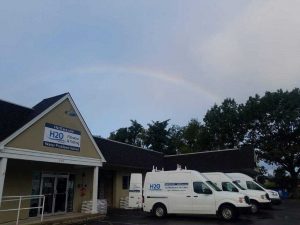WATER SOFTENER CONSIDERATIONS
The most commonly found water quality issues in Kingston are Manganese and Iron. Manganese and Iron are naturally occurring minerals commonly found in New England’s water supply. Together, they are commonly referred to as “The Stainers” in the water treatment industry and can be effectively removed with a water softener system through Ion Exchange technology. Hard water minerals can also be removed with water softeners. Hard water is evidenced by white scale build-up on plumbing fixtures, and difficulty in creating lather with soaps, shampoos and detergents (requiring more). Soft water makes a noticeable difference in cleaning, showering, shampooing your hair and cleaning your skin. For Kingston annual water quality reports, see the link at annual reports.

Water Softener & Sediment Filter
WATER TESTING
If you have a private well, water testing should be conducted by an EPA or Massachusetts state certified laboratory and should include analysis for at least the parameters in the table below. Depending on your specific situation, testing for a wider range of potential contaminants may be advisable. If you are uncertain as to how to take a proper sample and get it to a lab, you should contact a lab or water treatment professional for assistance. If your water is town supplied, they frequently test for health threat contaminants, therefore, an in-home water test can be performed on items such as iron, hard water minerals, manganese, pH or chlorine level. Typical items tested for at a lab are as follows:
| Coliform bacteria | pH |
| Arsenic | Radon |
| Chloride | Sodium |
| Iron | Sulfate |
| Lead | Conductivity |
| Manganese | Nitrogen-Nitrate |
| Hardness | Total Dissolved Solids |
BAD ODORS & TASTE IN WATER
For more on the removal of other bad odors and tastes in water, such as fishy, metallic, musty, etc., see the link at http://bad-odor-taste-water. Hydrogen Sulfide is evidenced typically by a rotten egg smell in your water. This may also be caused by high Manganese levels in the water as well. This problem is easily correctable with a water filtration system design specifically for this purpose, typically carbon filtration, aeration or ozone depending on the level detected.




